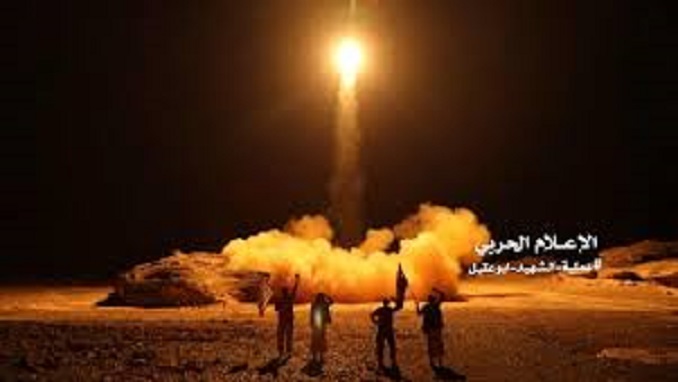The Saudi-led coalition in Yemen said on Thursday that it intercepted and destroyed a ballistic missile fired by Houthi rebels towards Saudi Arabia, Anadolu Agency reports. Coalition spokesman Col. Turki al-Maliki said the missile was fired towards Jizan in southwestern Saudi Arabia, according the official Saudi Press Agency, citing a statement.
Earlier on Thursday, the coalition also announced that it had intercepted and destroyed a Houthi booby-trapped drone launched towards southern Saudi Arabia, while the rebel group claimed that it had successfully targeted a facility of the Saudi Aramco oil company in Jeddah city with a missile.
Earlier, Yemen’s Houthi rebels said that had fired a missile at a Saudi Aramco facility in Jeddah, Saudi Arabia on the Red Sea – the latest in a series of cross-border missile and drone strikes the Yemeni group has claimed against the kingdom.
“The missile forces managed today to strike [a facility] of the Saudi Aramco company in Jeddah with a Quds 2 cruise missile. The strike was precise,” Houthi spokesman Yahya Sarea said.
There was no immediate confirmation of Thursday’s attack by the oil giant or the kingdom’s authorities.
Houthi spokesman Yahya Saree on Twitter claimed the rebels hit an Aramco facility in Jeddah with a Quds-2 missile at dawn on Thursday in retaliation for a six-year military campaign led by Saudi Arabia in Yemen.
He posted a satellite image online that matched Aramco’s North Jeddah Bulk Plant, where oil products are stored in tanks. The rebels claimed they hit the same facility last November, an attack the Saudi-led coalition later admitted had sparked a fire at the plant.
Saudi Aramco oil facilities are situated mostly in Saudi Arabia’s Eastern Province, around 1,000 km away from Jeddah. According to Flightradar24 data, aircraft either entered a holding pattern or were diverted to other airports around Jeddah.
Earlier, the Houthi movement had announced that it now controls most of Marib, a key city in Yemen.
“Most of Marib is now in the hands of the [Houthis],” Hussein al-Ezzi, the Houthis’ deputy foreign minister, told CNN Wednesday. “There are 14 districts that make up Marib, only two are controlled by the [internationally recognized government] including the city center, two others are battlefields and the rest of the districts are under Houthi control.”
The city sits on the eastern flank of Houthi territory, about 120 kilometers east of the capital of Sana’a, and is the largest city in northern Yemen still controlled by the government of President Abdrabbuh Mansour Hadi, who was ousted in early 2015 by the Houthi movement. However, it is also the capital of an oil-rich governorate and a key logistics hub for the region.
In February, violent clashes erupted over the Houthi movement’s attempts to advance toward Marib’s Sirwah district, home to a strategically important Yemeni government military encampment, located 30 kilometres away from the provincial capital.
The Houthis have said the Marib operation is essential to their push for the Saudi-led coalition to end its blockade of Yemen, which is responsible for greatly exacerbating the humanitarian crisis by restricting food and medicine imports.
More than 100,000 people have died in the conflict, nearly all of them Yemenis, and millions more are threatened with hunger and diseases such as dysentery and cholera, in addition to the COVID-19 pandemic.
However, some have challenged the Houthis’ claims. Ali Al-Sakani, a former journalist for Al-Masdar News and regular commentator on the activities of the Yemeni government, said on Wednesday that the Houthis had only captured five of Marib’s districts, two of which it has controlled since the start of the conflict in 2015.
Yemen has been struggling with an armed conflict between the government forces led by President Abd Rabbuh Mansur Hadi and the Houthi rebels since 2014.
A coalition of states led by Saudi Arabia launched a military operation to support the internationally recognized Hadi government in 2015. The Houthis continue to maintain control over a vast part in the north of the country, including the capital of Sanaa.
